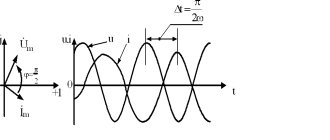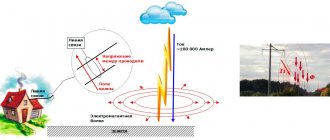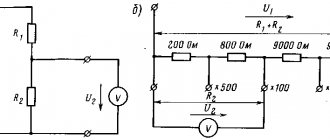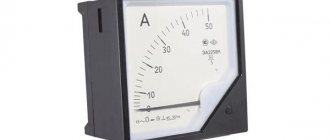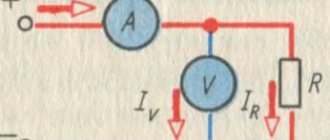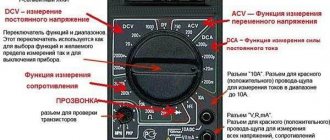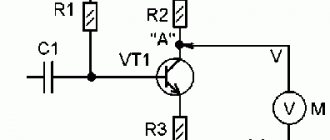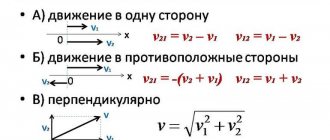Basic electrical quantities
- home
- Measuring instruments
Let's consider the basic electrical quantities that we study first at school, then in secondary and higher educational institutions. For convenience, we will summarize all the data in a small table. Definitions of individual quantities will be given after the table in case of any misunderstandings.
| Magnitude | SI unit | Name of electrical quantity |
| q | Kl - pendant | charge |
| R | Om - om | resistance |
| U | V – volt | voltage |
| I | A – ampere | Current strength (electric current) |
| C | F – farad | Capacity |
| L | Mr. Henry | Inductance |
| sigma | CM - Siemens | Electrical conductivity |
| e0 | 8.85418781762039*10-12 f/m | Electrical constant |
| φ | V – volt | Electric field point potential |
| P | W – watt | Active power |
| Q | VAR – volt-ampere-reactive | Reactive power |
| S | Va – volt-ampere | Full power |
| f | Hz - hertz | Frequency |
There are decimal prefixes that are used in the name of the quantity and serve to simplify the description. The most common of them are: mega, miles, kilo, nano, pico. The table shows other prefixes, except those mentioned.
| Decimal multiplier | Pronunciation | Designation (Russian/international) |
| 10-30 | cuecto | q |
| 10-27 | ronto | r |
| 10-24 | iocto | and/y |
| 10-21 | zepto | s/z |
| 10-18 | atto | a |
| 10-15 | femto | f/f |
| 10-12 | pico | p/p |
| 10-9 | nano | n/n |
| 10-6 | micro | μ/μ |
| 10-3 | Milli | m/m |
| 10-2 | centi | c |
| 10-1 | deci | d/d |
| 101 | soundboard | yes/da |
| 102 | hecto | g/h |
| 103 | kilo | k/k |
| 106 | mega | M |
| 109 | giga | G/G |
| 1012 | tera | T |
| 1015 | peta | P/P |
| 1018 | exa | E/E |
| 1021 | zeta | Z/Z |
| 1024 | yotta | Y/Y |
| 1027 | Ronna | R |
| 1030 | quecca | Q |
The strength of an electric current of 1A is a value equal to the ratio of a charge of 1 C passing through a surface (conductor) in 1 s of time to the time of passage of the charge through the surface. For current to flow, the circuit must be closed.
Current strength is measured in amperes. 1A=1Kl/1c
In practice there are
1kA = 1000A
1mA = 0.001A
1uA = 0.000001A
Electric voltage is the potential difference between two points in an electric field. The magnitude of electrical potential is measured in volts, therefore voltage is measured in volts (V).
1 Volt is the voltage that is necessary to release 1 Watt of energy in a conductor when a current of 1 Ampere flows through it.
The unit of electric current voltage is the following ratio: 1V=1W/1A.
In practice, the following variants of units of measurement of electric potential, or rather potential difference, are encountered:
- 1kV = 1000V
- 1mV = 0.001V
Electrical resistance is the characteristic of a conductor that prevents electric current from flowing through it. It is defined as the ratio of the voltage at the ends of the conductor to the current in it. Measured in ohms (ohms). Within certain limits the value is constant.
1 Ohm is the resistance of a conductor when a direct current of 1A flows through it and a voltage of 1V arises at the ends.
From the school physics course we all remember the formula for a homogeneous conductor of constant cross-section:
R=ρlS – the resistance of such a conductor depends on the cross-section S and length l
where ρ is the resistivity of the conductor material, tabular value.
Between the three quantities described above, Ohm's law exists for a DC circuit.
The current in the circuit is directly proportional to the voltage in the circuit and inversely proportional to the resistance of the circuit - Ohm's law.
I=U/R
Electrical capacitance is the ability of a conductor to accumulate electrical charge.
Capacitance is measured in farads (1F).
1F = 1Kl/1V
1F is the capacitance of a capacitor between the plates of which a voltage of 1V occurs when charged at 1C.
In practice there are
1pF = 0.000000000001F
1nF = 0.000000001F
Inductance is a quantity that characterizes the ability of a circuit through which electric current flows to create and accumulate a magnetic field.
Inductance is measured in henries.
1Gn = (V*s)/A
1H is a value equal to the self-inductive emf that occurs when the current in the circuit changes by 1A within 1 second.
In practice there are
1mH = 0.001H
Electrical conductivity is a value indicating the ability of a body to conduct electric current. Reciprocal of resistance.
Electrical conductivity is measured in siemens.
1cm = Ohm-1
How to choose a shunt for an ammeter
How to connect a pointer ammeter
Key Features
EP is represented by a special type of matter that occurs around charged elementary particles (protons and electrons). Experts have been studying this interesting phenomenon for decades. They were able to prove that it is through the electric shock that the influence of one stationary charge is transmitted to another. The final impact occurs in strict accordance with the world-famous Coulomb law.
Since there are no dense bodies within this distance, we can assert the existence of a certain invisible field. And since it is associated with specific phenomena, it began to be called electric. Such fields exist around all objects , only because of their invisibility and compensated interaction with each other, the impression is created that they are manifesting themselves.
You might be interested in this Symbol of radio components on the diagram and their name
Characteristics of measuring instruments
Measuring equipment devices have certain properties that are important for performing their immediate functions. These include:
- Metrological characteristics, such as sensitivity and its threshold, measurement range of an electrical quantity, instrument error, division value, speed, etc.
- Dynamic characteristics, for example, amplitude (dependence of the amplitude of the device’s output signal on the input amplitude) or phase (dependence of the phase shift on the signal frequency).
- Performance characteristics reflecting the degree of compliance of the device with the operating requirements under certain conditions. These include properties such as reliability of readings, reliability (operability, durability and reliability of the device), maintainability, electrical safety, and efficiency.
The set of characteristics of the equipment is established by the relevant regulatory and technical documents for each type of device.
Introduction to technology
Modern EP scales have found very interesting applications in the modern world. Experts have developed a method for wirelessly transmitting a signal from the main source to the consumer, although until recently everything was experimental and theoretical.
Today, there is already an effective implementation of the technology for charging smartphones without using a flexible cable. Of course, this option does not yet allow energy to be transmitted over long distances, but all functions are being improved.
It is worth noting that many people have already studied the electric field. The world-famous Serbian inventor Nikolai Tesla left a huge mark on history. Thanks to his efforts, he was able to achieve great success, but not in terms of energy efficiency.
Measuring
Devices intended for measurement must have standardized characteristics, and also retain for a certain time or reproduce the unit of the quantity for which they are intended to measure.
Instruments for measuring electrical quantities are divided into several categories depending on their purpose:
- Measures. These means are used to reproduce a value of a certain specified size - such as, for example, a resistor that reproduces a certain resistance with a known error.
- Measuring transducers that generate a signal in a form convenient for storage, conversion, and transmission. This kind of information is not available for direct perception.
- Electrical measuring instruments. These tools are designed to present information in a form accessible to the observer. They can be portable or stationary, analog or digital, recording or signaling.
- Electrical measuring installations are complexes of the above mentioned means and additional devices, concentrated in one place. The installations allow more complex measurements (for example, magnetic characteristics or resistivity) and serve as verification or reference devices.
- Electrical measuring systems are also a combination of various means. However, unlike installations, instruments for measuring electrical quantities and other means within the system are dispersed. Using systems, you can measure several quantities, store, process and transmit measurement information signals.
If it is necessary to solve any specific complex measurement problem, measuring and computing complexes are formed that combine a number of devices and electronic computing equipment.
Concept of measurements
The measurement of any physical quantity is made by comparing it with a certain quantity of the same type of phenomenon, adopted as a unit of measurement. The result obtained from the comparison is presented numerically in appropriate units.
This operation is carried out using special measuring instruments - technical devices that interact with the object, certain parameters of which need to be measured. In this case, certain methods are used - techniques through which the measured value is compared with the unit of measurement.
There are several signs that serve as the basis for classifying measurements of electrical quantities by type:
- Number of measurement acts. What matters here is whether they are once or twice.
- Degree of accuracy. There are technical, control and verification measurements, the most accurate measurements, as well as equally accurate and non-equally accurate.
- The nature of the change in the measured quantity over time. According to this criterion, measurements can be static and dynamic. Through dynamic measurements, instantaneous values of quantities that change over time are obtained, and through static measurements, some constant values are obtained.
- Presentation of the result. Measurements of electrical quantities can be expressed in relative or absolute form.
- A method for obtaining the desired result. According to this criterion, measurements are divided into direct (in which the result is obtained directly) and indirect, in which quantities related to the desired value by some functional dependence are directly measured. In the latter case, the desired physical quantity is calculated from the results obtained. Thus, measuring current using an ammeter is an example of a direct measurement, and power is an example of an indirect one.
Development of electrical measuring instruments and methods
The wide variety of means for measuring electrical quantities is due to many different phenomena in which these parameters play a significant role. Electrical processes and phenomena have an extremely wide range of use in all industries - it is impossible to specify an area of human activity where they would not find application. This determines the ever-expanding range of problems of electrical measurements of physical quantities. The variety and improvement of means and methods for solving these problems is constantly growing. The area of measurement technology such as measuring non-electrical quantities using electrical methods is developing especially quickly and successfully.
Modern electrical measuring technology is developing in the direction of increasing accuracy, noise immunity and speed, as well as increasing automation of the measuring process and processing of its results. Measuring instruments have evolved from the simplest electromechanical devices to electronic and digital devices, and then to the latest measuring and computing systems using microprocessor technology. At the same time, the increasing role of the software component of measuring devices is obviously the main development trend.
Impact principle
The properties of EP are most often constant and uniform. The planet has its own protective background, which has practically no effect on living organisms. Minor manifestations become noticeable to humans only during a severe thunderstorm. In such a situation, it may even seem that the air is trembling with tension. But for most people this does not pose any threat.
The technology industry does not stand still, thanks to which specialists are producing more and more different units, each of which is capable of generating its own electric shock. The indicator significantly exceeds the natural background, which is 0.5 kV/m. Of course, this feature did not go unnoticed by experts. As a result of numerous tests, they derived the maximum permissible voltage, which does not create restrictions for humans. Its size is 27 kV/m.
Even if you turn on all household devices at once, the maximum value will not be exceeded. An adult can receive a small percentage of negative effects only when spending a long time near high-voltage wires. In such an environment, the tension is very high, which is why standing for a long time or working in such an area is strictly prohibited. Specialists who, due to work circumstances, are forced to be surrounded by such electronic devices must have time to complete all work in a maximum of one and a half hours.
Coulomb's law
In this case, the force characteristic of the electric field works for a point charge located at a distance of a certain radius from it. If we take this indicator according to the standard modulus, then the result is a Coulomb field.
You may be interested in: Causes and consequences of a short circuit
The direction of the vector directly depends on the existing sign of the charge . If it is positive, then the EP will “move” along the radius. Otherwise, the vector itself will be directed towards the charge.
To understand the key features of the law, you can study the main drawings and diagrams that show lines of force. In textbooks, the main characteristics of EP are explained rather difficultly. If you use specialized literature to study this topic, then you need to take into account that when constructing drawings of power lines, their final density is proportional to the modulus of the tension vector. This is a kind of hint from experts that can help during an exam or just to check your knowledge.


